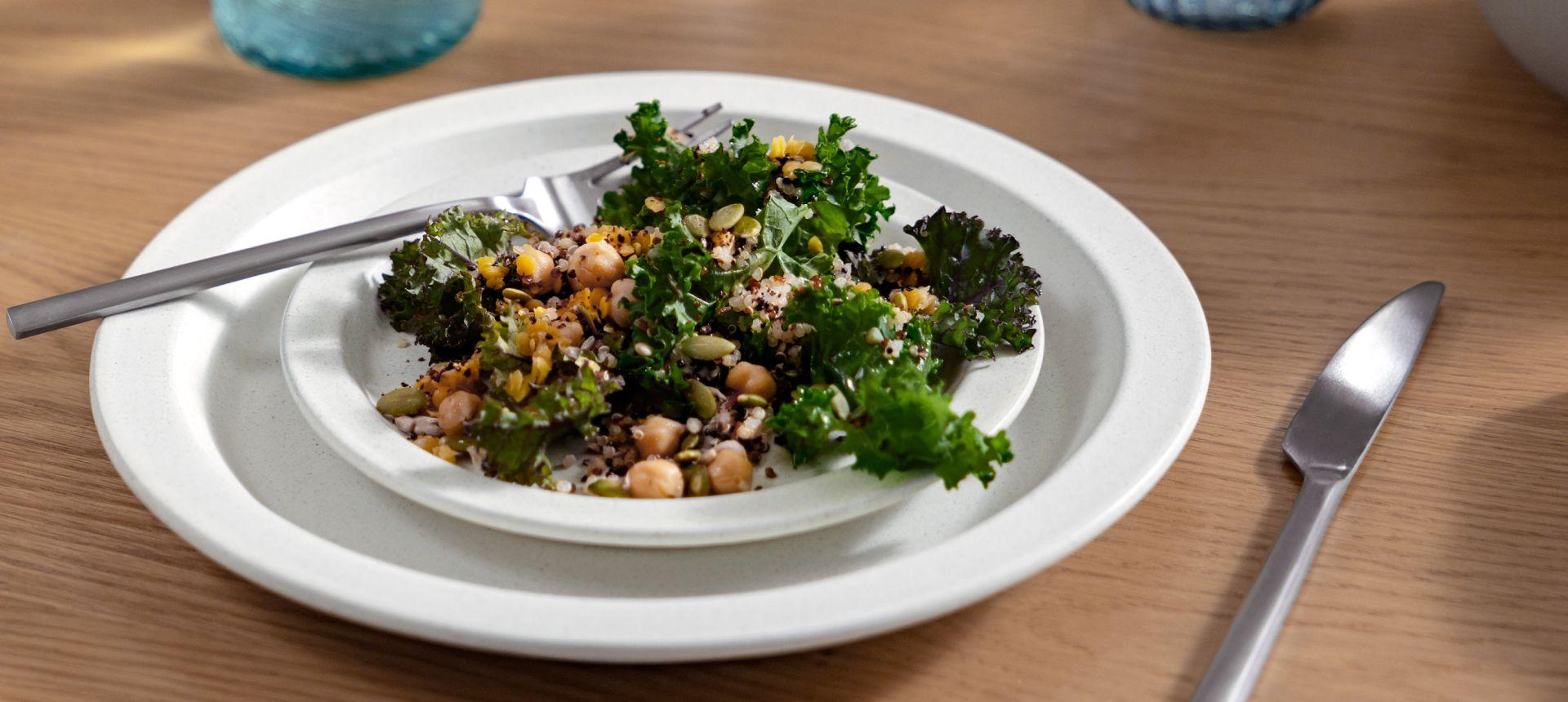Low-GI foods: Why they matter for glucose levels
Low-GI foods, slowly digestible starch, and resistant starches take longer to digest. Read about why they matter for glucose levels.
Sarah Koenck, MS, RD,
Medical Affairs
Published:
December 09, 2024
Updated:
March 04, 2025
Read time:
4 minutes

Low-GI (glycemic index) foods are digested more slowly and result in a smaller increase in blood sugar and insulin than high-GI foods.
Starches can be classified into three categories: slowly digestible starch, rapidly digestible starch, and resistant starch.
Low-GI foods, slowly digestible starch, and resistant starches take longer to digest and can help lessen spikes in glucose and insulin not only after the meal, but throughout the day. They can also help you to stay full for longer.
Start Lingo today for just $49
Learn how your body responds to food and exercise with a 2-week plan*, no commitment.
Buy now
All carbohydrates that you eat are eventually broken down into glucose to be used immediately by the cells or stored for later use. However, depending on the type of carbohydrate you eat, the time it takes for it to be digested and for the glucose to hit your bloodstream can vary. This will have an impact on how slowly or quickly you notice a glucose spike.
In this article, we’ll discuss different types of carbohydrates and their impact on your glucose (commonly referred to as blood sugar).
What is the glycemic index?
The most common way that people look at slow-release carbs is by classifying foods as high-glycemic or low-glycemic. The glycemic index (GI) ranks carbohydrates on a scale of 0-100 based on their potential to raise your blood sugar. Foods with a high GI (>70) are digested quickly and cause a rapid spike in blood sugar and insulin. Foods with a low GI (<55) are digested more slowly and result in a smaller increase in blood sugar and insulin.
High-glycemic foods are often foods that have been highly processed, beverages with lots of added sugar, bakery items, and candy.
High-GI foods (≥70)
Pretzels
Cornflakes cereal
White potatoes
Sweet potatoes
Sugar-sweetened sodas
Beer
Scones
Pancakes
Muffins
Croissants
White bread (GI 100)
Skittles
Some fruits with more sugar (pineapple, watermelon) are also considered high-glycemic, although they also offer beneficial nutrients and fiber.
Alternatively, low-glycemic foods are often whole foods such as non-starchy vegetables, low-sugar fruits, lean protein sources, whole grains, beans and legumes, dairy, and nuts and seeds.
Low-GI foods (≤55):
Avocados
Apples
Berries
Oranges
Spinach
Tomatoes
Cucumbers
Broccoli
Mushrooms
Steel-cut oats
Whole grain bread
Quinoa
Lentils
Chickpeas and hummus
Skim, low-fat, and full-fat milk
Greek yogurt
Chicken, turkey, and other poultry
Beef and pork
Eggs
Fish and shellfish
All about slow-release carbs
However, there is another category of slow-release carbs that is worthwhile to consider. Low-glycemic foods fall in several different food categories, but when it comes to starches (think: potatoes, beans, bread, rice, pasta, and cereals), we can further break these down into three main categories:
Slowly digestible starch (SDS)
Rapidly digestible starch (RDS)
Resistant starch (RS)
These categories represent the starches’ impact on glucose after they are consumed as well as the associated hormone response. It has been shown that foods with SDS have a lower glycemic index, independent of other nutrients in the food such as fat and fiber. 1
While fat and fiber also lead to a lower glycemic index, when eating foods that are pure carbohydrates (rice, pasta, bread), choosing those that have the greatest amount of SDS can have a significant impact on blood glucose, insulin, and satiety.
One study found that a breakfast containing SDS reduced the glycemic response not only after the meal, but also into the rest of the morning. This reduced response continued after lunch as well, 2 something called the “second meal effect.”
Why would eating a breakfast with SDS reduce your blood glucose well after the meal has been consumed and even into the next meal? Research has shown that not only does SDS slow the release of glucose into the bloodstream and induce a lower secretion of insulin, but they also reduce the amount of glucose produced by the liver as well as stimulate a slower release of gut hormones that help to keep you full. 3, 4
SDS is highest in starchy foods that have undergone the least processing. This includes beans and legumes, cooked vegetables like potatoes, corn, peas, and squash, grains like stone-ground wheat, quinoa, brown rice, rolled or steel-cut oats, oat bran, and barley. When cooked fresh, these foods contain higher amounts of SDS than more processed versions like potato chips, breads made with enriched flours, white rice, and instant oats.
What is resistant starch, exactly?
Resistant starch is another form of starch and is also known as digestion-resistant starch. This is because it acts similar to soluble fiber as it moves through your digestive tract undigested and can feed your gut with good bacteria, improving your overall microbiome. Because it does not get digested, it also helps reduce the glycemic response after a meal as well as the same “second meal effect” seen with SDS.
Additionally, it has been proposed that resistant starch may help with weight management as it has a lower energy density and may help promote satiety.
So where do you find resistant starch? Resistant starch has been categorized into five different types:
Type 1: Called physically inaccessible starch because it is bound in the fibrous cells walls and is found in foods such as coarsely ground or whole-kernel grains (quinoa, whole grain barley), seeds (pumpkin, flax), and legumes (chickpeas, lima beans).
Type 2: Found in unripe bananas (greener/not fully yellow bananas) and raw potatoes.
Type 3: This type of starch is found in starchy foods once they are cooked and then cooled. The cooling process turns some of the digestible starches into resistant starches.
Type 4: Chemically modified starch.
Type 5: Formed when starch interacts with lipids.
While this sounds complex, the easiest way to get resistant starch in your diet is to go for types 1-3 and opt for foods like cashews or less ripe or green bananas. Another simple and efficient way is to cook and cool certain starchy foods like rice and potatoes before eating them.
Benefits of slow-release carbs and low-GI foods
Slow-release carbs are those with a low glycemic index as well as those that contain high amounts of slowly digestible carbs or resistant starch. They have a lower impact on blood sugar and insulin and may even help lower glucose throughout the day into the next meal. Additionally, slow-release carbs may improve satiety by helping you feel fuller after meals.
A final note from Lingo
There are many ways you can include slow-release carbs in your diet. If you’re wearing a Lingo biosensor, you can test your own response to the suggestions below.
Choose whole grains: Opt for whole grains such as whole wheat pasta, brown rice, quinoa, and rolled oats instead of refined grains. These have a lower GI and provide slow-release carbohydrates.
Legumes and beans: Include lentils, chickpeas, black beans, or other legumes in your meals. They are rich in resistant starch and protein and can provide a sustained source of energy.
Green vegetables: Load up on non-starchy vegetables like broccoli, spinach, peppers, and kale. They are low in overall carbs, rich in fiber and nutrients, and the carbs they do contain are slow digesting.
Nuts and seeds: Snack on nuts and seeds like almonds, chia seeds, and pecans. Not only do they contain slow-release carbs, but they also have healthy fats and protein to help keep you fuller for longer.
Cooling and reheating: Cook, cool, and reheat certain starchy foods such as rice, potatoes, and pasta. This will increase their resistant starch content, making them slower to digest and a more even glucose profile.
The Lingo Glucose System is intended for users 18 years and older not on insulin. It is NOT intended for diagnosis of diseases, including diabetes.
The Lingo program does not guarantee that everyone will achieve the same results as individual responses may vary. Consult your healthcare professional before making changes to your diet or exercise regimen or if you have an eating disorder or a history of eating disorders.
© 2025 Abbott. All rights reserved. The biosensor shape and appearance, Lingo, and related brand marks are marks and/or designs of the Abbott group of companies in various territories. Other marks are the property of their respective owners.
ALB-02302
Published:
December 09, 2024
Updated:
March 04, 2025
Read time:
4 minutes


Sarah Koenck, MS, RD, is a Medical Affairs Specialist at Lingo. She’s been a registered dietitian since 2011 and has a master's degree in kinesiology from A.T. Still University. She spent the first part of her career as a clinical dietitian in the ICU before moving onto specializing in diabetes and weight management in the digital health space. Her personal health journey, including living with type 1 diabetes for almost 30 years and wearing a continuous glucose monitor for almost 20, has driven her commitment to help others at Lingo.
A healthy choice for your inbox
Sign up for Lingo emails to get science-backed tips, special offers, and The Journey Newsletter.
Start Lingo today
for just $49
Learn how your body responds to food and exercise with a 2-week plan*, no commitment.
- 1 Lingo biosensor with minute-by-minute continuous glucose monitoring
- Full access to the Lingo app, compatible with iPhone only. Designed for iPhone® 11 device or later.
Shop now
Free shipping | 30-day money-back guarantee†
*No commitment. This plan does not auto-renew (designed for iPhone® 11 device or later).
†30-day money-back guarantee is for first time purchases only

